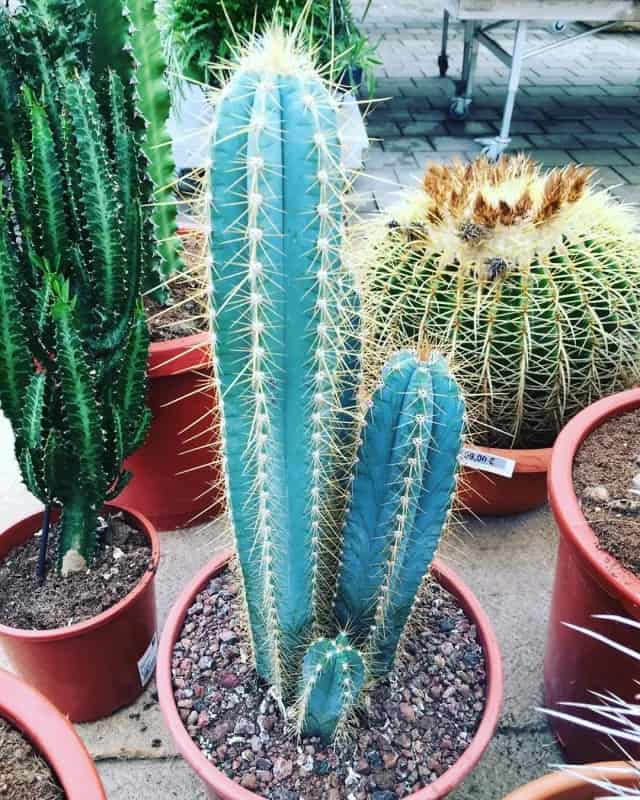The iconic blue color of Blue Torch Cactus fades away and turns bland green if you take their easy care for granted.
Thus, stick with me till the end so your Blue Torch Cactus stay happy and blue, striving for more.
Table of Contents Show
Overview of Blue Torch Cactus
The Blue Torch Cactus is a tall pillar Cactus species with unique blue stems and golden spines.
Interestingly, the blue hue gets more pronounced with gradual maturing when provided with excellent care.
| Indicator | Identity |
|---|---|
| Scientific Name | Pilosocereus pachycladus |
| Family | Pilosocereus |
| Plant Origin | South America, Caribbean |
| Plant Type | Succulent perennial |
| Hardiness Zone | 9-11 |
| Growth Rate | Slow |
| Growth Size | Indoor: 10-20 feet Outdoor: Up to 30 feet |
| Foliage | Hazy blue hued stem with noticeable ridges with regular spaced, creamy white areoles. |
| Bloom | Grows white/yellow flowers at night after attaining maturity and lasts for only a day |
| Bloom Season | Spring to early summer |
| Toxicity | Non toxic to humans and pets |
| Common Diseases | Bacterial rotting, fungal infections, phototoxicity |
| Common Pests | Red spider mites, mealybugs, aphids |
Blue Torch Cactus – Ultimate Care Guide
Let us dive right into the detailed care guide for your Blue Cactus without further delay, shall we?

1. Sunlight & Temperature
Being a desert plant, Blue Torch Cactus likes to bask in direct sun for 10-12 hours at 70-80°F temperatures.
Meanwhile, they can withstand temperatures >100°F but begins to shiver when the temperature drops <30°F.
Similarly, light-deprived Cactus will bend towards the light source, causing them to bend in a weird shape.
Although mature Cactus tolerate direct sun, young ones can not. Foliage turns brown and stems becomes thin and much lighter under excess sunlight.
Thus here are the tips for maintaining optimal sunlight and temperature for your Blue Torch.
- Low light: Place them near south or sunny windows, use incandescent lamps and give them full morning sunlight.
- Excess sunlight: Acclimate the plants to direct sun over a week before placing them in full sun.
- Low temperature: Take in the outdoor plants in winter and use frost blankets and heat pads.
- Extreme temperature: Regularly mist and water the plant and keep the plant away from direct sun exposure.
2. Watering & Humidity
Blue Cactus has a thick stem that stores water which becomes handy during dry, arid days.
Yet, they may also need more frequent watering if the humidity or spring and summer are low.
But they do not need much water in dormant winter. If you must, water them every 2-4 weeks in winter.

Remember, overwatered Cactus have discolored stems, stunted growth, and are prone to root rot. But underwatering issues induce dormancy in Blue Torch.
Moreover, the dehydrated Blue Cactus has a purple hue around its weak, fragile stems.
Thus, to land on a safety boat, ensure the topsoil is dry and use a moisture meter to water accordingly.
3. Soil & Fertilizer
Blue Torch Cactus prefers well-draining, loose, nutrient-rich soil of pH 6.1-7.3 with low water retention.
Meanwhile, it seemingly thrives well without regular fertilization. Yet, feed your plant with diluted liquid fertilizer or coffee grounds in spring and summer.
However, avoid fertilization in winter as they stay dormant with low to no nutrient intake.
Remember, inadequate fertilizers cause shriveling up and wrinkling in Blue Torch.
In contrast, overfertilization introduces salt build-ups, chemical root burn, and uncontrolled pupping.
4. Potting & Repotting
As a rule of thumb, Blue Torch Cactus prefer to sit in a pot that is half their size. And once potted, they won’t fuss for about four years.
While at it, use broad, shallow terracotta pots for your Blue Torch Cactus and fresh potting mix.
Moreover, to lower repotting stress, water the plant thoroughly and loosen up the soil using a blunt knife.
You can prune off the large, damaged, or old roots while repotting to reduce root rot risks.
5. Occasional Pruning
Blue Torch Cactus is a low-maintenance plant and hence does not require much pruning for its overall growth.
Besides that, you might need to prune Blue Torch Cactus to give them desired shape or control overcrowding.
Red spider mites, mealybugs, and aphids are the pests that attack the Blue Torch Cactus.
Meanwhile, root rotting and other fungal infections get triggered via overwatering and consistently high humidity.
In such peril, you shall prune off the infected parts using garden pruners and apply neem oil or fungicides.
Blue Torch Cactus: All About Growth
Blue Torch Cactus has a moderate growth rate and can grow about 1-2 feet yearly.
They grow actively in spring and summer but barely grow in winter as they stay dormant with low nutrient uptake.
Moreover, Silver Torch Cactus resembles the Blue Torch Cactus entirely, except that the spines are silver in color.
Each of those ridges is accentuated by regularly spaced, creamy white areoles from which long, brown spines emerge.

The unique Blue Torch is tall and upright, and its stems may become curved despite its upright growth habit.
With age, they get surrounded by hair-like structures that add a grayish look.
Almost all cactuses have peculiar flowers where the female reproductive part lies deeply sunken in a fleshy organ called receptacle!
Depending upon the size of the trunk, the size of the Blue Torch Cactus flower varies.
After successful pollination, they produce an edible fleshy wine-red fruit. After ripening, you can use them to harvest seeds.
Toxicity of Blue Torch Cactus
Regardless of their thorny looks, Blue Torch Cactus plant is non-toxic to pets and humans.
But they can cause harm from their sharp spines and hallucinogenic or psychedelic nature.
Moreover, if ingested, they can also introduce minor gastrointestinal upsets in pets.
Be careful not to ingest the plant as it contains the psychedelic substance mescaline, a strong hallucinogen.
Here are a few helplines you can rely on if anything unpleasant occurs with you or your pet.
- Animal Poison Control Center, APCC: (888) 426-4435
- National Capital Poison Center, NCPC: (800)222-122
Propagation Methods for Blue Torch Cactus
You can propagate Blue Torch Cactus via stem cutting and their seeds. But stem cutting is the most preferred method for its easy steps.
For optimal results and growth, propagate your Blue Cactus plant in early spring.
But ensure you have rooting hormone, sterilized shear, and fresh potting mix for propagating.
1. Stem Cuttings
We can use an adult healthy Cactus’s stem and the top part in this propagation method.
- Cut the adult cactus at least 4 inches long stem.
- Place the part in the shade for 7-15 days to dry and form a scab.
- Apply rooting hormones to the cut ends and let it be to form a callus.
- After light brown callus forms, plant the cutting in the prepared soil mixture.
- Firmly press the soil around the Cactus cutting to ensure its stability.
- Place the freshly planted pot in a bright place with average humidity.
- Water the cutting along the edges to keep the soil moist.
- Use a spray pump to water the soil.
Within 5-6 weeks, the fresh cuttings will likely have new root sprouts.
Once the propagated Cactus outgrows the pot, consider transplanting them into a bigger pot and proceed with regular care.
2. Seed Propagation
Seed propagation is meticulous, lengthy, and unpredictable process compared to stem propagation.
Before hopping on seed propagation, ensure you have viable fresh seeds harvested from ripe fruit.
Although the regular potting mix works fine, you can use a seed starter mix for better results.
- Sprinkle the seeds over the fresh potting mix in the germination tray.
- Ensure the seeds are not covered completely, as seeds need light for proper germination.
- Mimic a mini greenhouse by covering the tray with clear plastic and poking holes for air circulation.
- Keep the tray in a bright place with 50-70% humidity.
- Mist the surface of the pot regularly to maintain proper moisture.
After the plant grows over an inch long, transplant them into a separate pot.
Blue Torch Cactus for Sale
Blue Torch Cactus are not rare, although they give off an exotic, rare appearance. Here are a few online vendors with Blue Cactus for sale.
| Stores | Shipping Time |
|---|---|
| Amazon | Within 7-10 days |
| Desert Noir | Within a week |
| Succulents Depot | Within 1-3 business days |
| AceMegaSucculents | Within 3-5 days |
FAQs About Blue Torch Cactus
How Fast Does Blue Torch Grow?
They grow relatively slowly, but with ideal care, they can grow 1-2 feet yearly.
How Tall Do Blue Torch Cactus Get?
Blue Torch Cactus attain a staggering height of 30 feet in their natural habitat. However, indoor ones may only achieve 10 feet in height.
How Often do you Water a Blue Torch?
You can water your Blue Torch Cactus every 12 days with 0.8 cups or after the topsoil becomes dry.
How Often Does a Blue Torch Cactus Bloom?
The beautiful flowers of the Blue Torch Cactus bloom once a year for one night only.
From Editorial Team
Conclusion!
Blue Torch Cactus often grow well in desert-like conditions, so maintain warm temperatures and humidity with regular watering.
Beware of its love for direct sunlight, as young ones are blind and sunburned. Thus, gradually expose your Blue Cactus to the direct sun.
All The Best!


